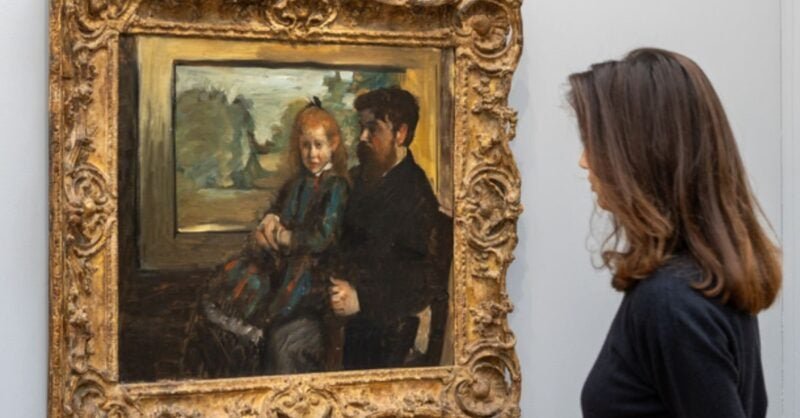

After a $6 billion slump in sales last year, there are signs of a recovery in the global art market.
HNW collectors report allocating an average of 20 per cent of their wealth to art in 2025, up from 15 per cent in 2024, according to a report from Art Basel and UBS.
The trend is most pronounced among the wealthiest buyers; UHNW collectors with assets exceeding $50 million allocated even more – around 28 per cent of their wealth.
The news has been welcomed by large auction houses after some recent disappointing results – Christie’s, Sotheby’s and Phillips collectively saw sales fall 19 per cent in 2023 and another 26 per cent in 2024.
[See also: The best art finance providers]
The recovery has been led largely by women and the younger generation taking bolder – and more diverse – investment risks, according to the Art Basel and UBS Survey of Global Collecting 2025.
In 2024 (the most recent year with complete data) women collectors spent, on average, 46 per cent more than men.
Women have an increasing tendency to take risks and support new artists, according to the report. Clare McAndrew, founder of Arts Economics and author of the report, said: ‘Contrary to the common stereotype of women as more risk-averse than men, the findings reveal that in the context of collecting, women are equally aware of potential risks yet often more willing to embrace them in practice – purchasing across a broader range of nontraditional mediums and actively supporting emerging and unknown artists.’
[See also: How big is the art market?]
Founder and chairman of advisory firm The Fine Art Group, Philip Hoffman told Spear’s: ‘Women tend to live longer than men, so they are huge inheritors of art collections, which means they are also increasingly more likely to spend time and money in art.’ With women now controlling more than a third of global wealth – a share expected to grow in the coming years – their influence on the art world is set to expand further.
The report also found that women collected and spent more on works by female artists, a trend that was particularly evident among younger collectors.
[See also: Monet to Mondrian: why these three paintings sold for over $40 million in 2025]
Bonnie Brennan, Christie’s Chief Executive Officer, told Spear’s: ‘The report always provides amazing insights into the wider market place and we can share that buying from younger female collectors (millennials or younger) is up in Christie’s global salerooms in the first half of 2025, very significantly in the luxury cluster, defined as jewellery, watches, handbags and wine, where their spend is up over 100 per cent a clear indication that our focus on selling exceptional art and objects is delivering.’
On average, Gen Z collectors allocate 26 per cent of their overall wealth to art, according to the findings. Not only that, but Millennials and Gen Z are entering the market with distinct tastes and behaviours, expanding beyond traditional art categories into digital, design, and lifestyle pieces.
Changing taste
Alongside shifting demographics come changing tastes and evolving ‘collecting appetites,’ as the report puts it. In the fine art sector, younger collectors are engaging with a wider variety of mediums: while Boomers remain the most active buyers of paintings, Gen Z collectors lead in digital, film, and video art, and Millennials show the strongest interest in prints, photography, and works on paper.

As these shifts in taste take shape, wealthy collectors have also diversified their spending in 2024 and 2025.
[See also: The best antiques and collectibles advisers]
Fine art remained the dominant area, with 78 per cent of respondents acquiring at least one fine art piece in 2024 and 74 per cent doing so in the first half of 2025. Paintings were still the most popular medium, representing 27 per cent of total fine art expenditure in 2024, though the proportion of buyers in this category declined compared to 2023.
But what’s more remarkable is that other mediums gained traction, with increased interest in sculpture, photography, and especially digital art. Notably, 23 per cent of HNWs planned to buy digital artworks – up from 19 per cent in the previous survey – with 26 per cent of Gen Z collectors indicating similar intentions.
[See also: The best art advisers]
‘The great wealth transfer is influencing more than just financial flows, it’s shaping collector engagement,’ said chief economist at UBS Global Wealth Management Paul Donovan.
He added: ‘As younger generations and more women assume stewardship of wealth, their collecting choices increasingly reflect personal values and social awareness. Many are drawn to art that speaks to identity, community, and purpose. This shift suggests a more reflective and values-driven approach to collecting, one that connects wealth with creativity and meaning in ways that resonate with the times.’
Moving towards greater stability in the art market
The Art Basel and UBS report shows cautious confidence in the art market’s near future. In the next 12 months, 40 per cent of HNWs plan to buy more art, a slight drop from 43 per cent in 2024. These plans don’t always come to fruition, however. In 2023 some 54 per cent of those surveyed signalled their intent to buy more in the next year, only for sales to fall in 2024.
According to the survey, fewer people want to sell. Selling intentions fell to 25 per cent from 55 per cent last year, which suggests ‘a market that is stabilising, maturing, and poised for continued evolution,’ the report notes. Overall, 84 per cent of respondents are optimistic about where the market is headed.

‘The art market is definitely experiencing a shifting ground, but that’s not necessarily doom and gloom,’ art market specialist Tanya Baxter tells Spear’s. ‘Like any commodity or industry, it has been exposed to huge geo-political issues in the last year. The economic downturn of the last year in the global economy has affected every business.’
[See also: The best art lawyers]
However, Baxter has observed a ‘significant recovery’ of the art market in the last two months, starting with the late September Karpidas auction at Sotheby’s, a ‘healthy sales report’ across both Frieze masters and Frieze as well as multimillion pound deals being transacted at Art Basel Paris.
The upward trend is partly a result of major banks encouraging clients to see art as an asset class rather than just an expense, said Hoffman. ‘The rise in art financing reflects growing recognition of art’s value as an investment.’ He added that with prices now down about 30 per cent, more people are spotting buying opportunities and want to invest.
McAndrew said the findings were encouraging signs for the future: ‘As wealth continues to shift both vertically and horizontally over the coming years, these trends are likely to foster greater balance and diversity in collecting in future.’












